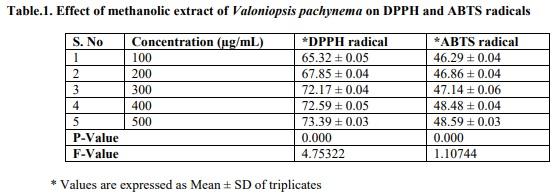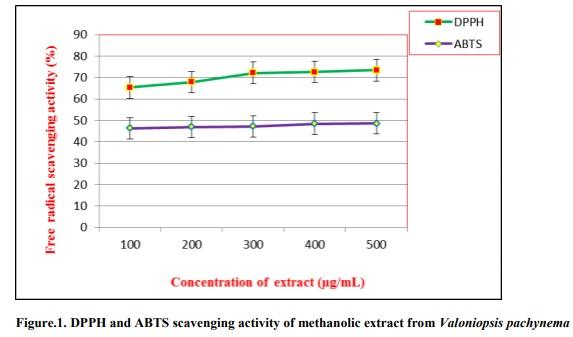INTRODUCTION
Free radicals are responsible for aging and causative agents of various human diseases. Antioxidant compounds play an important role in various fields such as medical field (to treat cancers, cardiovascular disorders, and chronic inflammations), cosmetics (anti-aging process) and food industries (food preservative) [1]. Seaweeds contain reactive antioxidant molecules, such as ascorbate and glutathione (GSH) when fresh, as well as secondary metabolites including carotenoids (α-and β carotene, fucoxanthin, astaxanthin), mycosporine-like amino acids (mycosporine-glycine), catechins (e.g., catechin, epigallocatechin, gallate, phlorotannins, eckol and tocopherols (α-,χ-δ-tocopherols) [2] Oxidative stress is a crucial etiological factor to the pathophysiology of variety of degenerative or pathological conditions such as aging, cancer, coronary heart disease, Alzheimer’s disease, atherosclerosis and inflammation [3,4]. Multiple mechanisms of enzymatic and non-enzymatic antioxidant systems are present in human body to protect the cellular molecules against reactive oxygen species (ROS) induced damage [5]. The present study was conducted to evaluate the free radical scavenging activity of methanolic extract of Valoniopsis pachynema.
MATERIALS AND METHODS
Collection of algae: The marine green alga was collected from Mandapam coast, Tamilnadu, South India.
Preparation of Algal extract: The freshly collected samples were soaked and thoroughly cleaned in sea water to remove the sand and salt contents and shade dried. Dried seaweeds was powdered and soaked in methanol (1:3, w/v) overnight and filtered to collect the methanol fraction. The residue was extracted two more times and the filtrates were combined and concentrated to obtain the crude extract. All the fractions were concentrated by evaporating under vacuum in a rotary evaporator and the dried extract was used for exploring its potential activity.
Invitro Antioxidant Assay: The antioxidant activity of methanolic extract of green alga Valoniopsis pachynema was examined. The two free radical systems like DPPH and ABTS were used for assessing the free radical scavenging activity of the test extract and the results were compared with the standard antioxidant Butylated hydroxytoluene and L-ascorbic acid.
DPPH radical scavenging activity: DPPH radical scavenging activity was measured by the spectrophotometric method [6]. In this method methanolic extract of green alga Valoniopsis pachynema was prepared in various concentrations from 100 to 500 µg/ml, each one of the above concentration was added to 0.05 ml of DPPH (200 µM). An equal amount of methanol was added to the control. After 20 minutes, the absorbance was read at 517 nm and the percentage of inhibition was calculated by using the formula Prasanth et al., (2000). The experiment was performed in triplicates.
Percentage of Inhibition = (Control-test) ------------------- X 100 Control
ABTS radical cation decolourisation assay: In this improved version of ABTS- , a free radical is generated by persulfate oxidation of 2, 2-azinobis (3- ethylbenzoline-6-sulfonic acid) - (ABTS2-). ABTS radical cation was produced by reacting ABTS solution (7 mM) with 2.45 mM Ammonium per Sulphate and the mixture was allowed to stand in the dark at room temperature for 12-16 hrs before use. For the study, different concentrations (100 to 500 µg/ml) of methanolic extract (0.5 ml) were added to 0.3 ml of ABTS solution and the final volume was made up with ethanol to make 1ml. The absorbance was read at 745 nm and the percentage inhibition was calculated
Percentage of Inhibition = (Control-test) ------------------- X 100 Control
All the determinations were carried out in triplicates. The IC50 the antioxidant activity in terms of the amount (μg/mL) of the extract necessary for inhibiting 50% of cell growth.
RESULTS AND DISCUSSION
In the present study, the free radical scavenging activities of methanolic extract from the experimental algae Valoniopsis pachynema were carried out using hydro soluble radicals DPPH and ABTS.
DPPH free radical scavenging activity: DPPH is stable free radicals that accept hydrogen to become a stable diamagnetic molecule. Hence DPPH is usually used as a substrate to evaluate the antioxidant activity [7]. The results showed that V. pachynema at the concentration 500 μg/mL had the higher DPPH scavenging activity of 73.39 ± 0.03% (Table. 1 and Fig. 1). The IC50 values of methanolic extract from the experimental algae V. pachynema was 79 μg/mL which was higher when compared to the standards BHT (34 μg/mL) and L-ascorbic acid (75 μg/mL) (Table.2). The result is indicative of the hydrogen donating ability of V. pachynema, since the effects of antioxidants on DPPH radical scavenging is thought to be due to their hydrogen donating ability [8]. The results of the present study are in line with Wang et al., (2009)[9] and Yan et al., (1999) [10], who also found that green algae contained higher amounts of polyphenols and DPPH radical scavenging activity than brown and red algae.
ABTS radical scavenging activity: ABTS free radical scavenging activity showed a maximum % of 48.59 ± 0.03 at the concentration 500 μg/mL (Table. 1 and Fig. 1) for Valoniopsis pachynema. The IC50 values of the methanolic extract from the experimental algae V. pachynema was 293 μg/mL which was higher compared to the standards BHT (33.5 μg/mL) and L-ascorbic acid (47.1 μg/mL) (Table. 2). The results of the present study indicate that the methanolic extract from the experimental algae has higher and significant effect on scavenging of ABTS radicals. The phenolic compounds may contribute directly to antioxidative action [11]. The antioxidative activity could be ascribed to the different mechanisms exerted by different phenolic compounds in the methanolic extract of the experimental algae.
CONCLUSION
The results showed that the methanolic extract from the experimental algae Valoniopsis pachynema had active hydro soluble radical scavenging activity against DPPH and ABTS.
Henceforth the algae V. pachynema may be used as good source of natural antioxidants. Furthermore studies are required to isolate and identify the active compounds from this alga and also screen for their in vivo studies, mechanism of action.
This article was originally published in World Journal of Pharmaceutical Sciences 2015; 3(10): 2074-2076. http://www.wjpsonline.org/.










